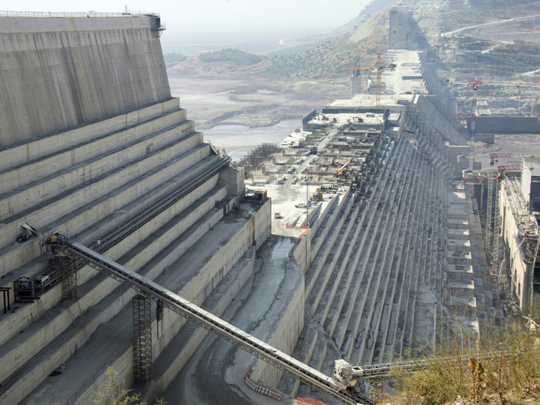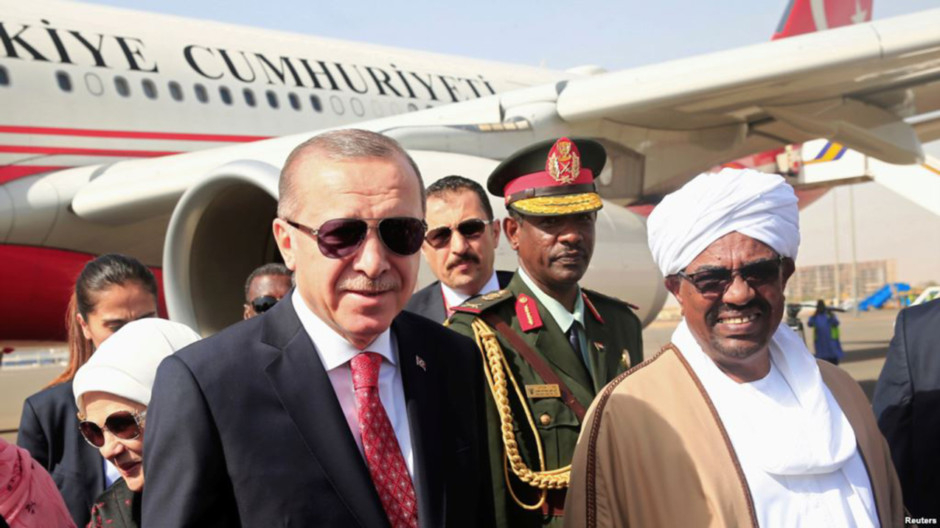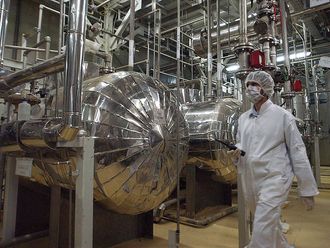
Cairo: New hope has emerged in the long-running diplomatic dispute over a dam Ethiopia is building on the Nile River, which Cairo sees as an existential threat.
On Thursday, Egypt’s President Abdul Fattah Al Sissi and Ethiopian Prime Minister Hailemariam Desalegn said they were opposed to any “conflict” over the sharing of Nile waters.
Al Sissi said that Desalegn’s visit was “a clear sign for our peoples and the entire world of our political will and determination to overcome all obstacles” between the two countries.
The Nile should serve as “a source of cohesion... and development, not of conflict” with Ethiopia, which is building a controversial dam that has raised Egyptian concerns over water supplies, he said.
“We agreed that we must make sure that this great river never becomes an object of competition, mistrust and conflict,” Desalegn told a joint news conference.
Al Sissi said Ethiopia was not aiming “to harm the interests of Egypt”, while reiterating Cairo’s call for the World Bank to serve as a neutral interlocutor between the two countries on technical issues related to the Nile.
Egypt relies almost totally on the Nile for irrigation and drinking water, and says it has “historic rights” to the river, guaranteed by treaties from 1929 and 1959.
Ethiopia’s Grand Renaissance Dam project on the Blue Nile, launched in 2012, is designed to feed a hydroelectric project to produce 6,000 megawatts of power, equal to six nuclear-powered plants.
The Blue and the White Nile tributaries converge in Sudan’s capital Khartoum and from there run north through Egypt to the Mediterranean.
Earlier this month, the situation looked like it was about to boil over as Egyptian and Eritrean troops massed on Sudan’s eastern border. Late last week, Sudan abruptly recalled its ambassador to Egypt, the latest chapter in a tussle that started last summer with trade boycotts and that has only intensified in recent weeks.
At heart, the bad blood is part of a broader regional conflict pitting Egypt, Saudi Arabia, and other countries against what they see as Turkey’s meddling in the region. Ankara has supported Qatar in its diplomatic battle with other Gulf states, and it is now jumping squarely into the Red Sea, making Egypt increasingly nervous. Cairo was particularly incensed when Turkish President Recep Tayyip Erdogan visited Sudan in December 2017 and won rights to Suakin Island, a port city on the Red Sea, raising concerns that Ankara could build a military base there.
That diplomatic dust-up is making it much harder to deal with another potentially explosive problem in the relationship: Sudan’s support for Ethiopia’s construction of a massive $5-billion dam on the Nile River that could choke off vital supplies of water downstream. Egyptian President Abdul Fattah Al Sissi has called the dam a matter of “life or death”.
All the regional rivalries around the Red Sea are intertwined, said Kelsey Lilley, associate director of the Africa Centre at the Atlantic Council, “but the dam itself is a big irritant among the three countries.”
And while the three countries have butted heads over the dam for years, the feud between Egypt and Sudan is escalating quickly.
“The tensions are significant and real and higher than they’ve been,” said Steven Cook, a North Africa and Middle East expert at the Council on Foreign Relations. “Things are starting to come to a head.”
The broader dispute has cemented a freeze in talks between Egypt, Sudan, and Ethiopia on how to manage the impact of the dam, even as the clock is ticking. The dam is more than 60 per cent complete, and Ethiopia could start to fill the reservoir as soon as this summer, leaving little time to find workable solutions.
“This should act as a political wake-up call for immediate action for joint decision-making on the filling issue, because 2019 will be a critical year,” said Ana Casco, an expert on the dam at the Stockholm International Water Institute, who has written extensively about it.
A dam at the head of the Blue Nile in the Ethiopian highlands has been a dream since the 1960s. But it was only in 2011 — when Egypt was rocked by the Arab Spring and facing domestic upheaval — that Ethiopia unilaterally decided to start work on the Grand Ethiopian Renaissance Dam, the biggest hydroelectric project in Africa.
Ever since, Egypt has been terrified of the potential impacts. The dam, a huge power project at the head of the Blue Nile meant to meet fast-growing Ethiopia’s need for more electricity, will hold a year’s worth of river flow behind its concrete walls. Depending on how quickly Ethiopia fills the dam, downstream flows to Egypt could be restricted — a potentially fatal threat for a country dependent on agriculture that is already facing severe water shortages.
Ethiopia could opt to fill the dam slowly over a period of as long as 15 years, which would minimise any impacts downstream even though it would delay the benefits of the dam. But Ethiopia, rocked by a year of anti-government protests that began in August 2016 and led to a 10-month state of emergency, likely can’t wait that long, Lilley said.
“Ethiopia’s government needs a win,” she said.
The dam prompted talk of Egyptian military action in 2013, with then-president Mohammad Mursi threatening that if the river’s flow were disrupted, “our blood is the alternative”. This week, announcing Egypt’s $4 billion plan to build a desalination plant to provide fresh water, Al Sissi vowed to protect Egypt’s share of Nile River waters.
The three countries seemed to have sorted things out in 2015 with an agreement on how to manage the project, but since then they have been unable to agree on how to even measure the dam’s impacts.
Now, the escalating fight between Egypt and Sudan threatens to torpedo cooperation. Ethiopian media reported in early January that Egypt had sought to sideline Sudan from talks over the dam; even though Egypt denied those reports, the very idea rattled Sudan.
And Sudan’s role is crucial, because it is smack in the middle of Egypt and Ethiopia geographically and politically. Egypt and Sudan have long divvied up the Nile’s waters between them, according to the terms of a 1959 treaty that does not include Ethiopia. By using less Nile River water than it was allotted, for years Sudan allowed more to flow downstream to Egypt, which has used more water than it is entitled to.
But in recent years, Sudan has sought to increase its own water use, aiming to boost its agriculture sector. Because it hopes to use the dam for irrigation, Sudan has moved closer to Ethiopia and become a supporter of the project. That makes antagonising Khartoum a dangerous gambit for Egypt, said Casco.
“If Egypt ‘loses’ Sudan — the only country it has a water allocation agreement with, and the only Nile riparian country which can pose significant threats to waters flowing downstream due to its high irrigation potential — that would be extremely risky for Egypt,” she said.
Officials at the embassies of Egypt, Ethiopia, and Sudan did not respond to requests for comment.
Egypt is already facing water shortages and could soon face “absolute water scarcity,” said CFR’s Cook.
To make matters worse, Cook said, the United States — still saddled with plenty of unfilled positions at the State Department — hasn’t been able to mediate the dispute. “There’s no referee in the room,” he said.
A US State Department official said, “We are concerned by the increase in tensions over the Nile and continue to urge the countries to find a cooperative way forward on the Grand Ethiopian Renaissance Dam.”
But they may find it hard to find a cooperative way forward in the near future. Egypt’s presidential election is slated for March, leaving Cairo little leeway in the meantime for political compromises on such a delicate issue.













